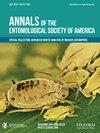Phoresy Involving Insects as Riders or Rides: Life History, Embarkation, and Disembarkation
IF 1.8
3区 农林科学
Q1 ENTOMOLOGY
引用次数: 3
Abstract
Abstract The ability to disperse is vital for all organisms, but especially for those whose habitats deteriorate, necessitating relocation to better feeding or breeding sites. Phoresy is assisted dispersal in which one organism uses another as its vehicle. In this review, phoresy will be largely restricted to cases wherein the rider is not parasitic on the vehicular stage used for dispersal, and in which insects are riders or rides. Phoresy occurs in organisms with limited mobility, and in secondarily brachypterous or completely wingless insects. Intraspecific phoresy also occurs. Generally, immature stages resistant to environmental assaults, such as dauers in nematodes, triungulins in beetles, or deutonymphs in mites, undertake phoresy. A size differential between rider and rider enables several conspecifics to board the same vehicle, likely ensuring mating opportunities at the destination. Riders may have special attachment devices or adhesive secretions to ensure safety during travel. Life cycles of riders and vehicles are often synchronized, and when phoresy is mutualistic, vehicles may also employ chemical tactics to achieve this synchrony. Chemical cues help to identify the appropriate vehicle, for disembarkation, or to lure the vehicle towards riders. Most riders prefer female vehicles, possibly to ensure access to rich nesting sites. Density-dependent selection may operate to limit the number of riders on a vehicle and phoresy may also facilitate sexual selection among riders. Whether vehicles can avoid phoresy is barely understood. This review attempts to place phoresy within a broad evolutionary context and points out the paucity of knowledge in certain research areas.以昆虫为骑乘者或骑乘者的旅行:生活史、登船和登船
分散能力对所有生物来说都是至关重要的,尤其是那些栖息地恶化的生物,它们需要迁移到更好的觅食或繁殖地点。传播是一种辅助传播,其中一种生物利用另一种生物作为载体。在本综述中,phoresy将主要局限于骑乘者不寄生在用于传播的载具阶段,并且昆虫是骑乘者或骑乘者的情况。phosiy发生在活动能力有限的生物体中,其次发生在短翅或完全无翅的昆虫中。种内虚假也会发生。一般来说,对环境侵害有抵抗力的未成熟阶段,如线虫中的道虫、甲虫中的三翅虫或螨虫中的双卫矛,进行寄主。骑乘者和骑乘者之间的体型差异使得几只同种的骑乘者可以登上同一辆车,很可能确保在目的地有交配的机会。乘客可能会有特殊的附着装置或黏附分泌物,以确保旅途中的安全。乘客和车辆的生命周期通常是同步的,当虚假是互惠的,车辆也可能采用化学策略来实现这种同步。化学线索有助于识别合适的交通工具,以便下船,或引诱交通工具向乘客靠近。大多数骑手更喜欢女性车辆,可能是为了确保进入丰富的筑巢地点。密度依赖的选择可以限制车辆上的乘客数量,而phoresy也可以促进乘客之间的性别选择。车辆是否能避免虚假信息几乎无人知晓。这篇综述试图将虚假置于一个广泛的进化背景下,并指出在某些研究领域缺乏知识。
本文章由计算机程序翻译,如有差异,请以英文原文为准。
求助全文
约1分钟内获得全文
求助全文
来源期刊
CiteScore
4.90
自引率
0.00%
发文量
25
审稿时长
6-12 weeks
期刊介绍:
The Annals of the Entomological Society of America exists to stimulate interdisciplinary dialogue across the entomological disciplines and to advance cooperative interaction among diverse groups of entomologists. It seeks to attract and publish cutting-edge research, reviews, collections of articles on a common topic of broad interest, and discussion of topics with national or international importance. We especially welcome articles covering developing areas of research, controversial issues or debate, and topics of importance to society. Manuscripts that are primarily reports of new species, methodology, pest management, or the biology of single species generally will be referred to other journals of the ESA. The most important criteria for acceptance are quality of work and breadth of interest to the readership.

 求助内容:
求助内容: 应助结果提醒方式:
应助结果提醒方式:


